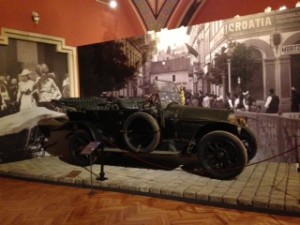VIENNA, Austria–The countdown started in Sarajevo in June 1914, the conflagration followed in August. The assassination of Austrian Archduke Franz Ferdinand by a Serb nationalist set in motion a series of events in which the great European powers marched, with near lockstep, into a war which would devour seventeen million people, devastate nations, and dismantle empires. And tragically as we know, World War I, the war to end all wars, tragically set the stage for World War II.
Looking at the car in which the Archduke Franz Ferdinand was shot and killed along with his wife, I felt slightly queasy, not so much because of the heinous specific act of terror was committed in this rather cramped auto, but what it would trigger, the Guns of August as the author Barbara Tuchman wrote.
 The car, an Austrian-built Graf & Stift Phaeton, on display in the Military Museum, looks small and rather cramped. The open auto in which the heir to the Austro-Hungarian throne rode in Sarajevo, that fateful 28 June a century ago, opens an exhibit on the First World War which commences with the optimistic and proud patriotism of 1914 but quickly descends into the depths of Dante’s inferno as the war progresses and devours all sides until 1918, and the disillusion of the multi-ethnic Austro-Hungarian empire.
The car, an Austrian-built Graf & Stift Phaeton, on display in the Military Museum, looks small and rather cramped. The open auto in which the heir to the Austro-Hungarian throne rode in Sarajevo, that fateful 28 June a century ago, opens an exhibit on the First World War which commences with the optimistic and proud patriotism of 1914 but quickly descends into the depths of Dante’s inferno as the war progresses and devours all sides until 1918, and the disillusion of the multi-ethnic Austro-Hungarian empire.
As the one leaves the Austrian Military Museum a banner reads, “Wars Belong in the Museums.” I agree.
But in the warm Summer sunshine outside the imposing Museum, we’re jolted into the present. View the Middle East’s grim landscape; Iraq under siege by a medieval Caliphate of Islamic fundamentalists, Syria’s gruesome civil war, Libyan chaos, conflict in Gaza. And then there’s Ukraine, a war on the doorstep of prosperous and self-absorbed Europe. Oh, and have we mentioned Afghanistan?
In 1914 we witnessed the clash of Empires; Austro-Hungary, Imperial Germany, and Ottoman Turkey facing Great Britain, France, Imperial Russia, and later the young United States. By WWII, and thereafter we saw the clash of totalitarian ideologies; Fascism, Nazism, Communism with the Free World.
Today we witness the clash of civilizations, as the great political scientist Samuel Huntington wrote, essentially the potential clash not so much with specific state political ideologies, but rather cultural/religious systems.
Some of these political/religious fault lines in the Mid-East date to WWI and the infamous Anglo/French, Sikes-Picot deal redrawing regional borders in Syria and the Levant.
So we transition from the terrorist Black Hand in Sarajevo a century ago to the ISIS black flags in Iraq and Syria today.
Contrary to 1914 when great empires with hubris and untested military power wished to strut on the world stage, today most countries, expect perhaps for the People’s Republic of China or Putin’s Russia choose to understate their power. Viewing China, Japan, Russia and Vietnam we see the lingering temptation to settle old scores over scattered islands the old fashioned way.
But Western European countries, Britain, France, Germany, and Austria are by experience risk-averse, and willing to heed the painfully learned lessons and the enduring costs of conflict. In both World Wars, even the European victors were bled white and devastated.
Yet today’s geopolitical challenges beg for solution, not studied detachment.
The United States, whose bi-partisan consensus helped the military play a vital globally stabilizing role in the post-WWII era, has lost its political bearings.
In the light of the past decade of Mid-East conflicts, America’s focus has become blurred. This is understandable, but still not an excuse. America’s President chooses to lead from behind with an almost aloof indifference.
In June when the Islamic State of the Levant (ISIS or ISIL) started their blitz across northern Iraq, the terrorists met with little resistance from a demoralized Iraqi army. Before long large swaths of the north, including the city of Mosul and the minority Christian areas of Nineveh province were under fundamentalist control. For two months, after seeing hundreds of thousands of refugees, mass executions, and facing a direct threat to the Kurdish regions, America finally acted with airstrikes on the terrorists. Too little, too late.
Yet the wider picture shows religious persecution and massacre of Christian and Yazidi minorities in Middle East, and this is 2014.
So a century after Sarajevo, the world looks perilously poised for another stunning event. Fortunately, the formal state powers have little appetite for conflict, but this then allows the gaggle of terrorist movements more regional leeway. The Obama Administration’s reluctant aloofness to overseas engagement creates a vacuum of stabilizing American leadership, which in turn has fueled growing global chaos.
John J. Metzler is a U.N. correspondent covering diplomatic and defense issues. He writes weekly for WorldTribune.com. He is the author of Transatlantic Divide ; USA/Euroland Rift (University Press, 2010)


You must be logged in to post a comment Login